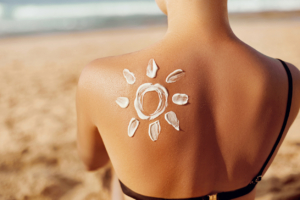
There are two types of sunscreen. Physical sunscreen and Chemical sunscreen. Below is a quick summary of the differences between the two.
Physical sunscreen = sunblock
Sunblocks protect by creating a barrier on the skin, blocking damaging rays of the sun by scattering and reflecting them away from the skin.
- Sunblocks do not get absorbed into the skin.
- Ingredients: Zinc Oxide and/or Titanium dioxide.
- Zinc Oxide is the only FDA approved ingredient that protects against both UVA and UVB rays.
- These two ingredients are the least likely to cause adverse skin reactions or clog pores.
- Physical sunscreens are often opaque and can leave a white cast. They are often thick and can take more effort to rub in.
- Effective immediately after application.
Chemical sunscreen = sunscreen
Sunscreens protect by a chemical reaction that occurs under the skin that turns UV rays into heat, which is then released from the skin.
- Suncreens get absorbed into the skin.
- Ingredients: Avobenzone, Octinoxate, Octisalate, Oxybenzone, Octocrylene.
- Some of these ingredients only protect against UVA or UVB, but not both.
- These chemical ingredients can cause skin irritation, redness and clogged pores.
- Chemical sunscreen formulas tend to be thinner, making them easier to spread evenly across the skin, leaving less residue.
- Chemical sunscreen must be applied at least 20 minutes before sun exposure, as it’s not effective immediately.
Recommendations:
Chose a broad-spectrum sunscreen that protects against UVA and UVB rays. According to the American Academy of Dermatology, it’s best to go for anything with an SPF of 30 or higher. Reapply as often as 2 hours. Always read and follow the recommendations of the manufacturer.
